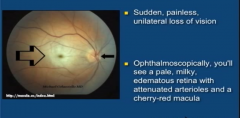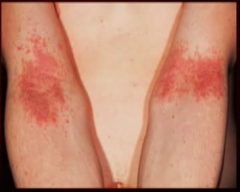![]()
![]()
![]()
Use LEFT and RIGHT arrow keys to navigate between flashcards;
Use UP and DOWN arrow keys to flip the card;
H to show hint;
A reads text to speech;
38 Cards in this Set
- Front
- Back
|
Sudden, painless loss of vision, with flashes and floaters
|
Retinal detachment
Treatment: Tilt head back to allow spontaneous reattachment. Optho consult for reattachment |
|
|
Age related macula degeneration types and treatment.
|
Dry type, releases drusen which occludes vision. No proven treatment. Antioxidant vitamins A, C and E may help.
Wet type, new blood vessels occlude vision. Treatment w laser photocoagulation |
|

blurry vision is only complaint
|
central retinal vein occlusion. Different from central artery occlusion on fundoscopy. In CVO, blood can get into retina, but can't get out, so you get increased pressure and extravasation (hemorrhage and edema) as opposed to the pale retinal of CAO. No spec therapy, Don't heperinize bc can increase bleading and cause blindnes
|
|

|
Central artery occlusion.
treatment like stroke. 1. antithrombolytics: aspirin and heparin 2. eyeball massage/pressure |
|
|
Glaucoma pathophys and treatment
|

aqueous humor is made in the ciliary body, travels from posterior to anterior chamber and exits canal of schlem. When iris dilates, scrunches up like rolling up a shirt and blocks exit. Treatment is based on 1) stopping production of AqH w prostoglandin inhibitors, 2) constricting the pupil with beta blockers and pilocarpine, 3) placing a hole to facilitate drainage.
|
|

What is the diagnoses
|

Abnormal cup to disc ratio from glaucoma. Normal ratio is cup is no more than 30% of ratio. As aqueous humor builds up, ratio increases, can lead to blindness. Must stop production of aqueous humor. Use acetozolamyde, latonoprost, betablockers, pilocarpine, and mannitol.
|
|

diagnoses
|
Cataracts. Opacification of lens
Caused by trauma, aging, and sunlight. Treatment is surgically replace the lens |
|

Diagnoses
|
Sub conjunctival hemorrhage
Note: sclera is the white of the eye, conjunctiva is the clear layer that extends over the sclera attaching to the cornea (clear layer over pupil and iris) at the limbis. Therefore the blood stops at the limbis. Not sight threatening. Caused by low platelets and trauma. Reabsorbs spontaneously |
|

Diagnoses
|
Keratitis, opposite concept of subconjuntival hemorrhage...effects the keratin of the cornea. Site threatening. Often caused by herpes. On visual exam you see nothing b/c cornea is so clear you can't perceive the damage. Pt will have pain, sight threatening, but nothing visible. Use flouracene which binds to the cornea that is denuded (loss of layers) so the damage lights up (same with visualizing cornea abrasion). If damage is from trauma, will grow back in a day. Pitfall. Uveitis is defined as inflammation of the uveal tract of which the anatomy includes the iris, ciliary body, and choroid. The iris regulates the amount of light that enters the eye, the ciliary body produces aqueous humor and supports the lens, and the choroid provides oxygen and nourishment for the retina. When the inflammation is limited to the iris it is termed iritis. If the ciliary body is also involved, then it is called iridocyclitis. Treated with steroids. But if you give steroids to keratitis, you make them blind
|
|

|

|
|

|

|
|

|

|
|

|

1) A Dennie–Morgan fold, also known as a Dennie–Morgan line or an infraorbital fold, is a fold or line in the skin below the lower eyelid caused by edema in atopic dermatitis. The presence of Dennie–Morgan folds is used as a diagnostic marker for allergy.
2) Ichthyosis vulgaris: very dry skin, fish like scales. 3) Pityriasis alba is a common skin condition mostly occurring in children and usually seen as dry, fine-scaled, pale patches on the face. It is self-limiting and usually only requires use of moisturizer creams. |
|

|
1) hyper linear palms
2) Keratosis pilaris is a common, autosomal dominant, genetic follicular condition that is manifested by the appearance of pink tiny papules (rough, slightly red, bumps on the skin). It most often appears on the back and outer sides of the arm (though the forearm can also be affected), and can also occur on the thighs, hands, and tops of legs, sides, buttocks. Feels like goosebumps to pts |
|

|
Hand dermatitis: can be atopic, contact, psoriasis
|
|
|
Treatment for atopic derm: maintenance
|

|
|
|
treatment for atopic derm: therapy
|

|
|
|
Dx for Dizziness
|
1) vertigo
2) syncope: arrhythmia, aortic stenosis, orthostatics 3) seizure (electrical) 4) Disequilibrium--elderly+DM+peripheral neurop+night= no sensory input from eyes, "floating"=falls |
|
|
vertigo syndrome
|
nystagmus
vertigo postural instability N/V |
|
|
Vertigo types
|
How long does it last?
seconds: BPV min-hrs: TIA, miniere's (will have hearing loss), migraine variant, recent surgery/trauma (fistula) DAYS: labyrintitis vs inferior cerebellar stroke. (Labyrintitis will be in the young w no stroke risk and physical exam of peripheral symptoms; inferior cerebellar stroke will be in the older, will have stroke risks, on PE will have central findings. |
|
|
PE for vertigo
|
Look for nystagmus, do complete neuro exam (focal findings?), qualifiying symptoms.
Nystagmus: peripheral vertigo will be horizontal, fatiguable when gazed is fixed, worse towards fast phase; Central will verticle or rotational Neuro exam: central causes will have focal findings, can't walk. Peripheral will have a romberg where they fall away from fast phase, they can walk but perhaps with difficulty |
|
|
Vertigo treatment
|
labaryntitis can treat with antivert
Central causes, need MRI and admit to ICU |
|
|
GI bleed Approach
|
A-Bring advanced airway and resus equip to bedside, prepare for intubation
B-oxygenate. Low Hb, therefore raise saturation to 100% C-Hypotensive, give 2L NS/lactated ringer, then blood as needed. If they are on aspirin, think of replacing platelets. Less than 20-50? FFP, 10-15ml/kg. Think about giving desmopressin (DDAVP). IOUT: NG tube, folly and follow urine out put, EKG, CXR (looking for free air, correct placement of minnesota tube if used troponin, PT/PTT, type screen/cross, cbc, bmp/cmp?, lactate? |
|
|
variceal GI bleed treatment
|
octreotide 50micrograms bolus+50micrograms/hr
Abx (ceftriaxone, or cefotaxime, or PO cipro 500-700 x 7 dys) Protonix 80mg bolus+8mg/hr Once stable, beta blocker or nitrates Endoscopy (even if octreotide controls bleeding, always do endoscopy |
|
|
GI Bleed Dx
|
usually upper GI: usually variceal.
|
|
|
priapism types
|
low vs high flow
High flow: from things like trauma. Blood is fast in and fast out. No pain. Treat w angiography w interventional radio Low flow: disease of cavernosa. Caused by vasoactive drugs injections (prostaglandins), sickle cell, and drugs like heparin, steroids in body builders. Treat with ice and exercise, terbutaline 5-10mg PO x 2 q 20min (SC .25-.5mg), phenylephrine PO. If doesn't work inject 1) phenylephrine 200mics, put turnecat at base of penis so it doesn't become systemic and then monitor BP, can give second and third doses. 2) or use epinephrine or norepi injections. 3) or methlene blue (but will turn penis blue a few days) 4) or use sildinofil. Variant of intermittent priapism in sickle cell. use baclofan, dig, or phenylephrine injections. |
|
|
Dialisis: common complications
|
fluid overloaded and edema before dialisis, fluid depleted after. Fever from bacteria in extracorporal flow.
Increase K before, decreased K after, both can cause arrythmias. Na, Mg, Ca, dialized drugs can all lead to seizures |
|
|
Dialisis: rules for emergency dialysis.
|
1) refractory increased potassium
2) refractory acidosis 3) acute pulmonary edema 4) coagulopathy (uremia can lead to decrease platelet function) 5) ATN 6) uremic encephelapothy and uremic carditis. |
|
|
dialysis
|
most that die in ED is from sepsis
be careful w RSI, sux bumps K by 1 albuterol decreases K by 1 Dig more toxic with low K |
|
|
esophogeal rupture risk factors
|
scoped recently (can present up to 2 wks after)
ETOH w N/V |
|
|
Esophogeal rupture symptoms
|
fever
chest pain SOB subcutaneous emphysema tachy (can present looking like PE) meclers triad: chest pain, vomiting, subcutaneous emphysema |
|
|
esophageal perforation: workup
|
Xray: shows pleural effusion, pneumomediastinum
Esophogram (if xray normal) replace barium w/ water soluble contrast (doesn't rule out if normal) CT chest (if normal esophogram), doesn't give location of porforation |
|
|
esophogeal perforation treatment
|
Abx
thoraxic surgery consult |
|
|
esophageal perforation risk factors
|
HIV+candida
increase pressure from lifting/#2/vomit tubed scoped |
|
|
Hematemesis approach
|
Two populations
1) actively bleeding Give erythromicin 3mg/kg IV 30 min before scope 2) Reported bleed NG tube (doesn't rule out |
|
|
Hematemesis epi
|
most common causes are variceal, followed by PUD
|
|
|
Hematemesis treatement
|
80% stop bleeding w/out treatment
of those who rebleed, most do so in first 72 hrs decreasing acidity lowers chances of rebleed (raise stomach pH above 6) protonix 80mg bolus + 8mg/hr infusion octreotide will help non variceal bleeds as well add abx early in variceal bleeds pressure on variceal veins causes rebleed, |
|
|
Hematemesis workup
|
check level of increase heart rate and decreased BP
check liver failure symptoms (variceal) NG tube check H/H endoscopy |

